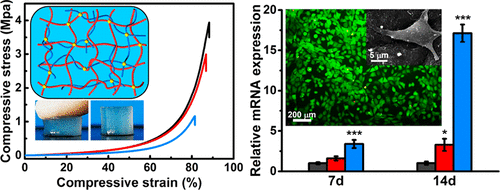当前位置:
X-MOL 学术
›
Biomacromolecules
›
论文详情
Our official English website, www.x-mol.net, welcomes your feedback! (Note: you will need to create a separate account there.)
Rubbery Chitosan/Carrageenan Hydrogels Constructed through an Electroneutrality System and Their Potential Application as Cartilage Scaffolds
Biomacromolecules ( IF 6.2 ) Pub Date : 2018-01-02 00:00:00 , DOI: 10.1021/acs.biomac.7b01456 Xichao Liang 1 , Xiaolan Wang 2 , Qi Xu 1 , Yao Lu 2 , Yu Zhang 2 , Hong Xia 2 , Ang Lu 1 , Lina Zhang 1, 3
Biomacromolecules ( IF 6.2 ) Pub Date : 2018-01-02 00:00:00 , DOI: 10.1021/acs.biomac.7b01456 Xichao Liang 1 , Xiaolan Wang 2 , Qi Xu 1 , Yao Lu 2 , Yu Zhang 2 , Hong Xia 2 , Ang Lu 1 , Lina Zhang 1, 3
Affiliation

|
In the present work, the bulk and homogeneous composite hydrogels were successfully constructed from positively charged chitosan (CS) and negatively charged carrageenan (CG) in alkali/urea aqueous solution via a simple one-step approach for the first time. An electroneutral CS solution was achieved in alkali/urea, leading to a homogeneous solution blended by CS and CG, which could not be realized in acidic medium because of the agglomeration caused by polycation and polyanion. Subsequently, the CS/CG composite hydrogels with multiple cross-linked networks were prepared from blend solution by using epichlorohydrin (ECH) as the cross-linking agent. The composite hydrogels exhibited hierarchically porous architecture, excellent mechanical properties as well as pH- and salt-responsiveness. Importantly, the composite hydrogels were successfully applied for spreading ATDC5 cells, showing high attachment and proliferation of cells. The results of fluorescent micrographs and scanning electronic microscope images revealed that the CS/CG composite hydrogels enhanced the adhesion and viability of ATDC5 cells. The alcian blue staining, glycosaminoglycan quantification, and real-time PCR analysis proved that the CS/CG composite hydrogels could induce chondrogenic differentiation of ATDC5 cells in vitro, exhibiting great potential for application in cartilage repair. This work provides a facile and fast fabrication pathway for the construction of ampholytic hydrogel from polycation and polyanion in an electroneutrality system.
中文翻译:

通过电中性系统构建的橡胶壳聚糖/角叉菜胶水凝胶及其作为软骨支架的潜在应用
在目前的工作中,首次通过简单的一步方法成功地从碱性/脲水溶液中的带正电的壳聚糖(CS)和带负电的角叉菜胶(CG)成功地构建了块状和均质的复合水凝胶。在碱/尿素中获得了一种电中性的CS溶液,导致CS和CG混合而成的均匀溶液,由于聚阳离子和聚阴离子引起的团聚,在酸性介质中无法实现。随后,使用表氯醇(ECH)作为交联剂,从混合溶液中制备出具有多个交联网络的CS / CG复合水凝胶。复合水凝胶表现出分层的多孔结构,出色的机械性能以及pH和盐响应性。重要的,该复合水凝胶成功应用于散布ATDC5细胞,显示出高附着力和细胞增殖能力。荧光显微照片和扫描电子显微镜图像的结果表明,CS / CG复合水凝胶增强了ATDC5细胞的粘附性和生存能力。阿尔辛蓝染色,糖胺聚糖定量和实时PCR分析证明,CS / CG复合水凝胶可在体外诱导ATDC5细胞的软骨形成分化,在软骨修复中具有广阔的应用前景。这项工作为在电中性体系中由聚阳离子和聚阴离子构建两性水凝胶提供了便捷的制造途径。荧光显微照片和扫描电子显微镜图像的结果表明,CS / CG复合水凝胶增强了ATDC5细胞的粘附力和生存能力。阿尔辛蓝染色,糖胺聚糖定量和实时PCR分析证明,CS / CG复合水凝胶可在体外诱导ATDC5细胞的软骨形成分化,在软骨修复中具有广阔的应用前景。这项工作为在电中性体系中由聚阳离子和聚阴离子构建两性水凝胶提供了便捷的制造途径。荧光显微照片和扫描电子显微镜图像的结果表明,CS / CG复合水凝胶增强了ATDC5细胞的粘附力和生存能力。阿尔辛蓝染色,糖胺聚糖定量和实时PCR分析证明,CS / CG复合水凝胶可在体外诱导ATDC5细胞的软骨形成分化,在软骨修复中具有广阔的应用前景。这项工作为在电中性体系中由聚阳离子和聚阴离子构建两性水凝胶提供了便捷的制造途径。实时荧光定量PCR分析表明,CS / CG复合水凝胶可体外诱导ATDC5细胞软骨分化,在软骨修复中具有广阔的应用前景。这项工作为在电中性体系中由聚阳离子和聚阴离子构建两性水凝胶提供了便捷的制造途径。实时荧光定量PCR分析表明,CS / CG复合水凝胶可体外诱导ATDC5细胞软骨分化,在软骨修复中具有广阔的应用前景。这项工作为在电中性体系中由聚阳离子和聚阴离子构建两性水凝胶提供了便捷的制造途径。
更新日期:2018-01-02
中文翻译:

通过电中性系统构建的橡胶壳聚糖/角叉菜胶水凝胶及其作为软骨支架的潜在应用
在目前的工作中,首次通过简单的一步方法成功地从碱性/脲水溶液中的带正电的壳聚糖(CS)和带负电的角叉菜胶(CG)成功地构建了块状和均质的复合水凝胶。在碱/尿素中获得了一种电中性的CS溶液,导致CS和CG混合而成的均匀溶液,由于聚阳离子和聚阴离子引起的团聚,在酸性介质中无法实现。随后,使用表氯醇(ECH)作为交联剂,从混合溶液中制备出具有多个交联网络的CS / CG复合水凝胶。复合水凝胶表现出分层的多孔结构,出色的机械性能以及pH和盐响应性。重要的,该复合水凝胶成功应用于散布ATDC5细胞,显示出高附着力和细胞增殖能力。荧光显微照片和扫描电子显微镜图像的结果表明,CS / CG复合水凝胶增强了ATDC5细胞的粘附性和生存能力。阿尔辛蓝染色,糖胺聚糖定量和实时PCR分析证明,CS / CG复合水凝胶可在体外诱导ATDC5细胞的软骨形成分化,在软骨修复中具有广阔的应用前景。这项工作为在电中性体系中由聚阳离子和聚阴离子构建两性水凝胶提供了便捷的制造途径。荧光显微照片和扫描电子显微镜图像的结果表明,CS / CG复合水凝胶增强了ATDC5细胞的粘附力和生存能力。阿尔辛蓝染色,糖胺聚糖定量和实时PCR分析证明,CS / CG复合水凝胶可在体外诱导ATDC5细胞的软骨形成分化,在软骨修复中具有广阔的应用前景。这项工作为在电中性体系中由聚阳离子和聚阴离子构建两性水凝胶提供了便捷的制造途径。荧光显微照片和扫描电子显微镜图像的结果表明,CS / CG复合水凝胶增强了ATDC5细胞的粘附力和生存能力。阿尔辛蓝染色,糖胺聚糖定量和实时PCR分析证明,CS / CG复合水凝胶可在体外诱导ATDC5细胞的软骨形成分化,在软骨修复中具有广阔的应用前景。这项工作为在电中性体系中由聚阳离子和聚阴离子构建两性水凝胶提供了便捷的制造途径。实时荧光定量PCR分析表明,CS / CG复合水凝胶可体外诱导ATDC5细胞软骨分化,在软骨修复中具有广阔的应用前景。这项工作为在电中性体系中由聚阳离子和聚阴离子构建两性水凝胶提供了便捷的制造途径。实时荧光定量PCR分析表明,CS / CG复合水凝胶可体外诱导ATDC5细胞软骨分化,在软骨修复中具有广阔的应用前景。这项工作为在电中性体系中由聚阳离子和聚阴离子构建两性水凝胶提供了便捷的制造途径。



























 京公网安备 11010802027423号
京公网安备 11010802027423号